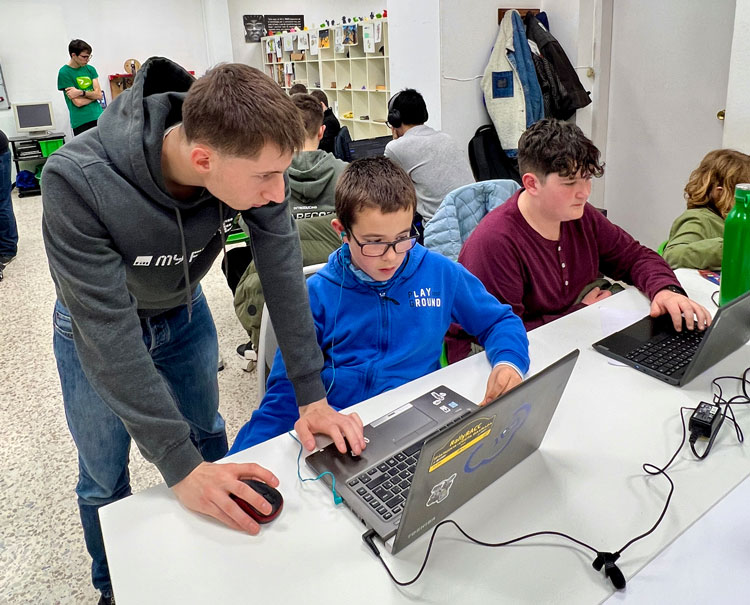Learning to code is an exciting journey that opens up a world of possibilities, letting you become a creator. It’s discovering how video games work, what’s behind the apps we use on smartphones, and understanding what makes a robot spring to life. But like any learning process, the first steps are often full of obstacles. Most beginners make the same mistakes when they start coding… and the good news is that every single one of them can be fixed.
At Codelearn, we say it all the time: making mistakes isn’t bad—in fact, it’s a sign you’re learning and progressing. The key is recognizing your mistakes, understanding why they happened, and turning them into opportunities to improve. In this post, we’ll go over the most common mistakes beginner programmers make and share tips on how to overcome them.
1. Being afraid to make mistakes
Many students think that if an error pops up on their screen, they’ve broken the program forever. That feeling of “I’m not cut out for this” or “this is too hard for me” is very common—and dangerous—because it blocks learning. The truth is that every error is like a clue from your computer, showing you which part of your thinking needs work.
The trick is to shift your mindset: instead of seeing mistakes as failures, see them as helpful messages pointing you in the right direction. Even the best programmers in the world make mistakes constantly—they rarely get their code perfect on the first try. The difference is that they’ve learned how to interpret what those errors are telling them.
2. Trying to learn everything at once
Programming is a huge universe: languages, libraries, tools, projects… It’s normal for beginners to feel tempted to tackle everything at once, thinking it will make them progress faster. But that kind of ambition often leads to frustration. Trying to make a full-fledged video game before mastering basic logic is like attempting a marathon without ever training.
The solution is simpler than it seems: start small. A mini-game in Scratch or a short Python program may seem modest, but it’s a solid step that paves the way for bigger challenges. Programming is like building a house—brick by brick.
3. Copying code without understanding it
With so many tutorials and examples online, it’s tempting to just copy and paste code without thinking about what each line does or why you’re using it. And when you try to create something from scratch, you have no idea where to start.
The key is to experiment and tinker yourself. Copying an example is fine, but the real value comes from modifying it. Changing a number, removing a line, or adding a different conditional teaches you how the program actually works. Instead of memorizing a recipe, you’re learning how to cook.
4. Forgetting logic and obsessing over syntax
Sure, a misplaced parenthesis can ruin an entire program, but syntax isn’t everything. The real focus should be on the logic behind the code. Many beginners get so caught up in memorizing commas and semicolons that they forget to think about the bigger picture of what they’re trying to build.
A very effective technique is to pause before writing anything and sketch out a plan on paper. A flowchart or a simple step-by-step list can save you a lot of time. Once the logic is clear, syntax becomes a minor detail you can fix with practice.
5. Thinking programming is only for geniuses
Few misconceptions are as damaging as this one. Many people believe programming is reserved for those with a natural talent for math or a “gift” for technology. Nothing could be further from the truth. At Codelearn, we’ve always believed anyone can learn to code.
Programming is a skill that can be trained—just like learning an instrument, speaking a foreign language, or mastering a sport. Just like you learn to ride a bike or play the piano, you can learn to code: it’s all about consistent practice, persistence, making mistakes, and trying again. It’s not about being a genius—it’s about sticking with it.
6. Giving up too soon
Getting stuck is inevitable: a bug that you can’t trace, a program that won’t respond, a function that doesn’t work as expected… At this point, many students throw in the towel. But this is exactly where the most valuable learning happens.
The advice is simple: break the problem into smaller parts. Solve it step by step rather than tackling everything at once. And if you’re still stuck, explain the problem to someone else—even if they don’t know how to code. Surprisingly often, just saying it out loud leads to the solution.
7. Not practicing enough
Reading a programming book or watching a YouTube tutorial can give you ideas, but it won’t make you a programmer. The only real way to learn is by writing code. Just like you can’t learn piano by only reading sheet music, you can’t learn to code by only reading theory.
The key, as we said earlier, is consistency. You don’t need to spend hours at your computer every day—15 to 20 minutes daily is enough for your brain to get comfortable with programming. Over time, these small sessions add up, and progress becomes obvious. That’s why we always recommend Codelearn students log into the platform daily to practice exercises and reinforce what they learned the day before.
The importance of mistakes
In conclusion, mistakes when learning to code aren’t obstacles—they’re part of the process. In fact, they’re one of the best tools for progress. At Codelearn, we encourage students to see every bug as a challenge and every setback as an opportunity to improve. Because programming isn’t about writing perfect code on the first try—it’s about learning to think, solve problems, and create solutions.
The next time something doesn’t work, don’t get discouraged. It means you’re learning—and every line of code is taking you one step closer to becoming a real programmer.

